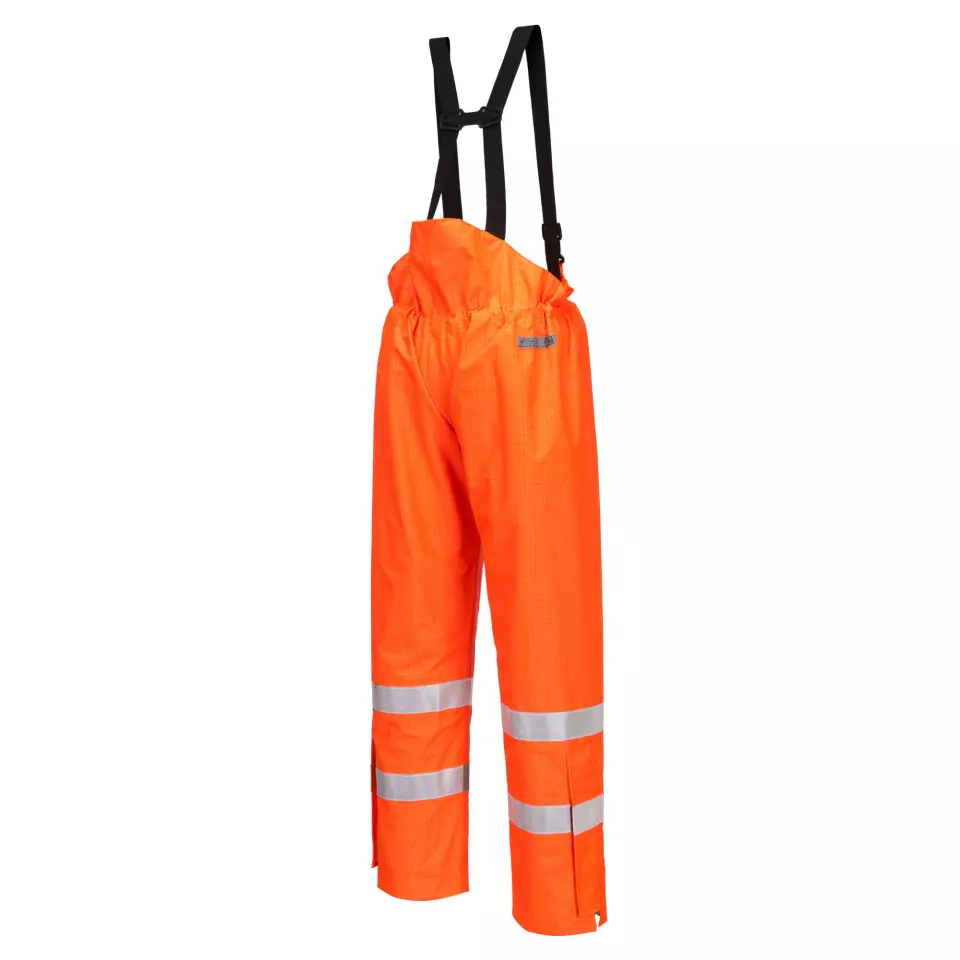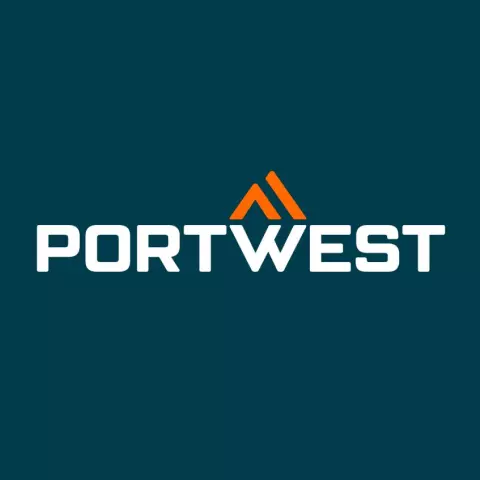Portwest Bizflame Rain Unlined Hi-Vis Antistatic FR Trousers, Orange
Portwest
visit storeProduct description
These flame resistant shell trousers combine waterproof protection with breathability and antistatic properties for demanding work environments. The garment features a fully elasticated waistband with back waist buggy for enhanced comfort and protection, while zipped ankles allow easy fitting over work boots. Premium flame resistant reflective tape and taped seams provide comprehensive safety features, meeting multiple international standards including EN ISO 20471 Class 1 for high visibility and EN 343 Class 3:3 X for waterproof performance.
Product Features:
- Flame resistant treated waterproof fabric prevents water penetration
- Zipped ankles for easy fitting over work boots
- Back waist buggy for added protection
- Ergonomic quick release buckle system with braces
- Premium sew on flame resistant reflective tape
Technical Details:
- Unlined construction
- Anti-static properties
- Breathable fabric to draw moisture away from the body
- Taped seams for additional protection
- Fully elasticated waistband for comfort
Standards:
- CE certified, CE-CAT III, UKCA marked
- EN ISO 14116 Index 1
- EN 1149-5
- EN 13034 Type PB [6]
- EN ISO 20471 Class 1
- RIS 3279 TOM Issue 2 (Orange Only)
- EN 343 Class 3:3 X
Defines the primary functional design category, such as base layer, disposable, or rain gear, indicating the pants' intended use and performance characteristics.
The primary color of the work pants, affecting visibility, professional appearance, and compliance with workplace dress codes or safety requirements.
Design elements on the leg portion like reflective stripes, side zips, or reinforcement patches that enhance safety, functionality, and durability.
Determines how the pants are cut and proportioned to accommodate different body types, affecting comfort, mobility, and appearance during work activities.
The method used to secure and adjust the fit around the waist, affecting comfort, adjustability, and ease of wear during work activities.
The protective material applied to the fabric surface, providing specific benefits like water resistance, chemical protection, or enhanced durability.
The method used to fasten and secure the pants at the waist, affecting ease of wear, adjustability, and comfort during work activities.
- Heat & Flame Resistance
- High Visibility
- Electrical Protection
- Water Resistance
- Machine Washable
Request a free sample
Test first and buy later. Visit any product page to request your free sample.
Standards and labels
EN 343 is a European standard for protective clothing against bad weather. It says clothes must be waterproof, breathable, and not let water in. It's used to protect workers in different industries like construction and transportation. Tests must show the clothing meets these standards.
Test results
Downpour XEN 343:2019 is a standard that delineates requirements and assessment methodologies for protective clothing, specifically tailored to garments intended to offer protection against precipitation and wet conditions.Result X signifies that the garment's performance in resisting water penetration during simulated downpours has not been specified or assessed. The practical implications of this result are notable, as it indicates that the garment may not offer adequate protection against heavy rain and prolonged exposure to wet conditions, potentially compromising wearer comfort and safety, particularly in outdoor work environments where protection from inclement weather is paramount.
Breathability Class 3Breathability performance in the category of Class 3 under the standard EN 343:2019 reflects a high level (RET<20) of breathability for protective clothing. This category is designed to provide comfort and prolonged wearability in environments requiring good air permeability through the garment. Specifically, Class 3 is the highest class, indicating excellent breathability properties which are tested and certified to meet stringent regulations for vapor permeability and resistance. The practical implication of a Class 3 breathability result in EN 343:2019 is that the fabric offers superior breathability, making it suitable for use in garments worn in active work or in environments where higher air permeability is necessary to reduce the risk of heat stress and to maintain comfort during extended wear.
Waterproofness Class 3EN 343:2019 is designed to ensure that protective clothing provides specific levels of protection against rain, considering its waterproof capabilities. Class 3 in this standard represents the highest level of waterproofness, indicating that the garment successfully resists a high volume of water penetration (more than 13000 Pascal Pressure units after pre-treatment). The test method used involves simulating wet weather conditions, where the fabric is exposed to varying degrees of water projections and pressures to evaluate its resistance. Fabrics that achieve Class 3 certification tend to have undergone rigorous testing such as high-pressure spray tests or being subject to a controlled volume of water for a defined period. These are particularly relevant for professional use in extremely wet environments where the highest level of water resistance is necessary, providing critical protection in conditions from heavy rain to immersion scenarios. This high classification impacts the practical usability of such clothing in industries such as outdoor work, marine activities, or emergency services where maximum protection from water exposure is critical for safety and performance.
EN 13034:2005 is a European standard that specifies the requirements and test methods for Type 6 protective clothing designed to provide protection against liquid chemicals. This standard sets criteria for the fabric's resistance to penetration by liquid chemicals and establishes guidelines for the overall design and construction of the clothing. It ensures that Type 6 protective clothing offers reliable protection for workers in industries where they may be exposed to liquid chemical hazards, but it may not be suitable for protection against airborne particles.
Test results
Liquid Chemical Protection Type 6 PBEN 13034:2005 specifies the performance requirements for protective clothing that offers limited protection against liquid chemicals, identified specifically as Type 6 PB (partial body protection). The 'Type 6 PB' designation implies that the protective garment has been tested and confirmed to provide effective defense against light spray and minor splashes of liquid chemicals, but only for parts of the body such as aprons, sleeves, or boots rather than full body suits. This standard tests the fabric's barrier effectiveness by applying a defined volume of liquid to the garment and assessing any penetration or repellence under controlled laboratory conditions. Garments achieving Type 6 PB classification are crucial for tasks in industries like chemical processing or handling where full body coverage is unnecessary, thereby offering flexibility and targeted protection, reducing the risk of chemical exposure to critical areas of the body.
EN ISO 20471:2013 is a standard for high visibility clothing worn in certain work environments. It sets guidelines for clothing to make sure people can see the person wearing it well in low light conditions. Test results are used to make sure the clothing meets these rules. The tests include checking the amount of reflective material on the clothing and how well it can be seen from different angles.
Test results
Reflective Strip Area Grade 1EN ISO 14116:2015 is a standard that deals with the flammability of clothing and other materials used to protect against heat and flame. It includes tests to measure how long it takes for a material to catch fire and how long it takes for the fire to spread. The standard also includes performance requirements for materials to be used in certain situations, such as those that are worn by firefighters or oil and gas workers. Possible test results include how well a material meets the standard's requirements for flammability and how well it performs in different conditions.
Test results
Flame Spread Test Index 1CE Marking is a label that shows a product meets certain safety and environmental standards set by the European Union. To get the CE Marking, a company must test and certify their product meets these standards. CE Marking is required for many products sold in the EU, including electronics, machinery, toys and medical devices. It helps ensure that products are safe for consumers and the environment, and allows for easy trade within the EU.
PPE stands for "personal protective equipment." PPE Category 3 refers to equipment that is complex and provide the highest level of protection such as powered respirators, SCBA, and full body suits. In Europe, PPE Category 3 must meet certain safety standards set by the European Union, which means that it must be designed and manufactured to protect the user without causing harm. Companies that make or sell PPE must prove that it meets these standards. They also must have a quality management system in place, have to be audited regularly by a notified body and have to have a technical documentation.
Portwest delivery terms
Free delivery when you order more than 300,00 € from Portwest
Supplier shipping fee 4,74 €
Brand minimum 20,00 €
66,15 €
Shipping fee is 4,74 € for orders under 300,00 €
Sold in units of one piece
Need larger quantities?
Other products you may like
Recently viewed
Need help?
Get help from our experts
Other products you may like
Similar products you may like
Autonomous sourcing platform
The most efficient way to source and order supplies for your operations
Sourcing
Ordering
List products you’re looking for and we’ll find the best products and prices for you – all for free.
Need help?
Get help from our experts



